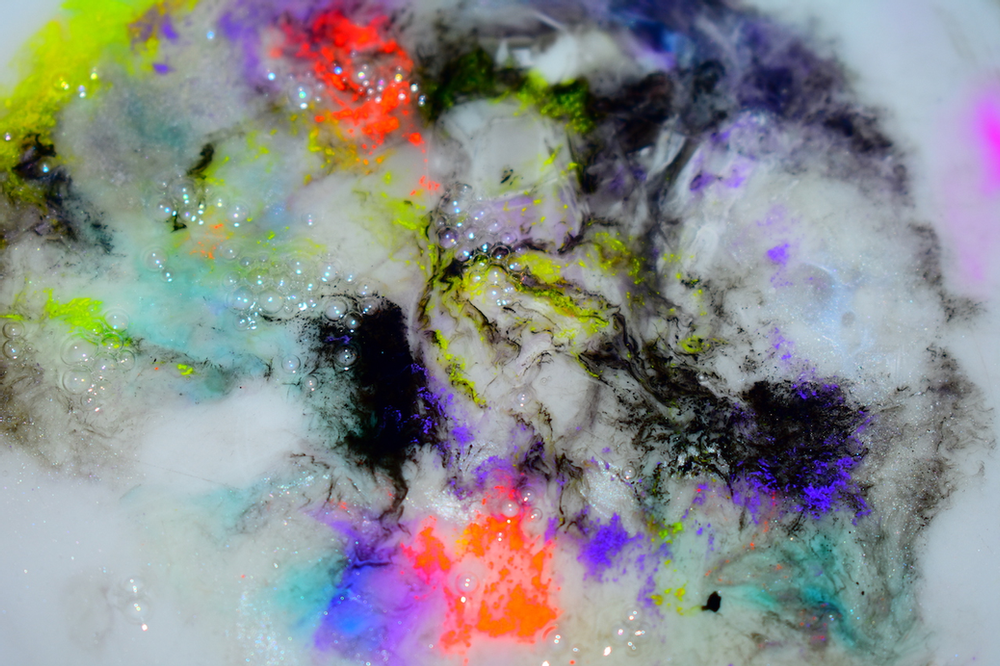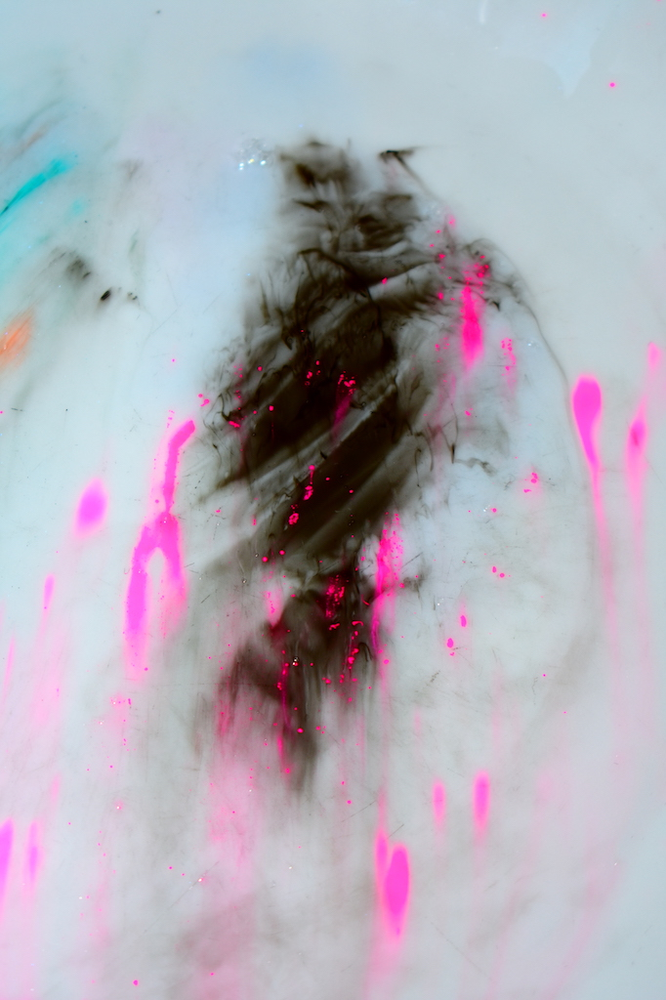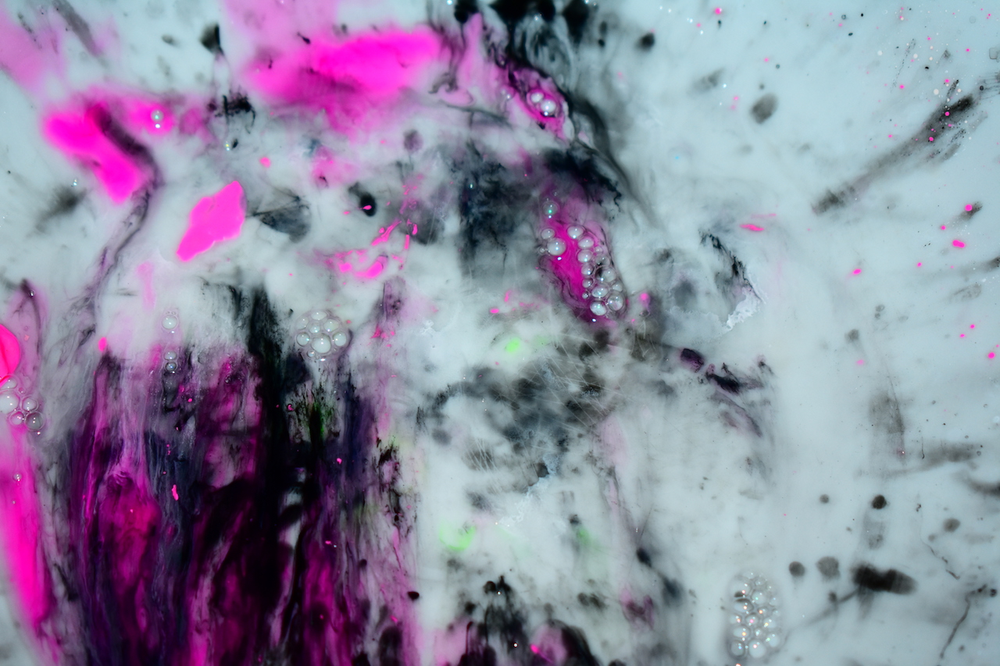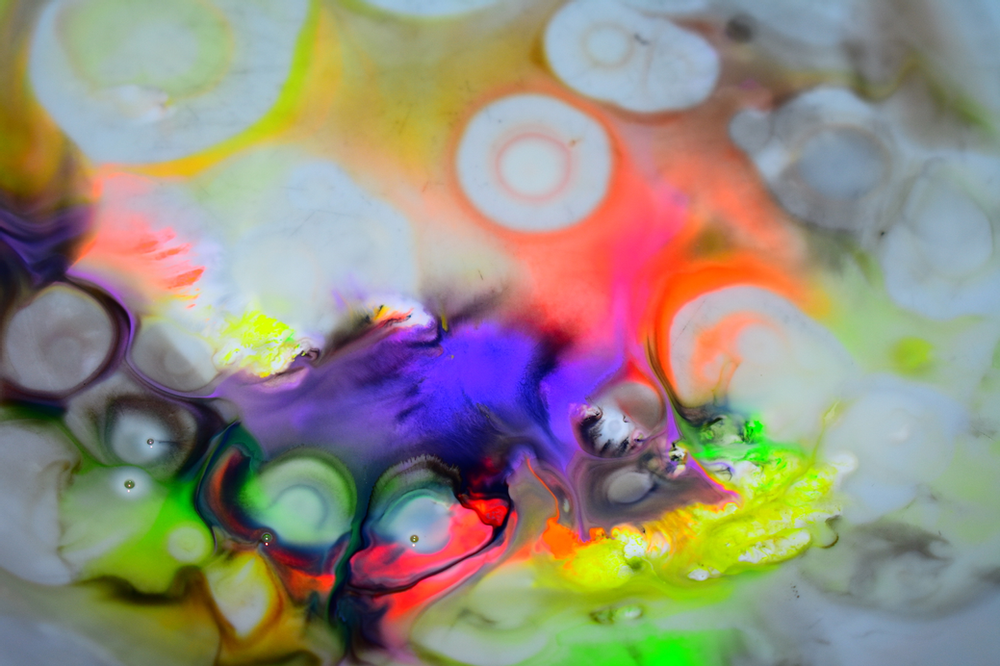
Martin Luisi
Malgrado la consapevolezza di una forte attitudine verso l’espressione artistica, esistono percorsi che inducono le persone a scegliere sbocchi professionali diversi pur mantenendo quel forte contatto con l’impulso creativo come valvola per liberare le emozioni più profonde, per confrontarsi con sentimenti più o meno travolgenti che hanno bisogno di essere manifestati, raccontati. Martin Luisi ha preso coscienza della sua indole artistica negli anni giovanili, incentivato dal padre che lo ha sempre sostenuto nella realizzazione del suo sogno; poi però la vita lo ha condotto verso un tipo di professionalità differente, necessaria per affrontare la contingenza e per costruirsi una base solida in virtù della quale poter sviluppare ulteriormente il parallelo percorso creativo. Inizialmente più vicino alla pittura che è diventata terapeutica negli anni che sono seguiti alla scomparsa dell’amato padre, nel corso del tempo si è appassionato di fotografia a alle modificazioni delle immagini attraverso la digitalizzazione, sperimentando così una Digital Art completamente personalizzata in cui sono i liquidi in movimento a essere protagonisti di immagini appartenenti all’Espressionismo Astratto, attraverso cui Martin Luisi spiega e libera gli stati d’animo, le sensazioni percepite e i moti interiori da cui si sente avvolto quando si confronta con la propria intimità. Attraverso le sue opere l’artista non solo immortala una realtà in continuo movimento, quella dei liquidi di per sé tendenti a scorrere e a fluire, bensì li manipola agendo direttamente su di essi per raggiungere il risultato desiderato senza avvalersi delle innovative tecniche di trasformazione e ritocco della fotografia ideate verso gli anni Settanta del Novecento e che hanno subìto una rapida evoluzione nel corso del Ventunesimo secolo e che è facilmente alla portata di tutti. Dunque Luisi si distingue proprio per la sua ricerca precedente allo scatto e per il rifiuto di ricorrere a una post produzione, rendendo così il suo procedimento artistico decisamente unico; agisce secondo una genuinità espressiva di cui lo scatto rappresenta solo e unicamente la sintesi di una fusione tra pensiero ed emozione, tra impulso del sentire e meditazione figurativa di ciò che l’interiorità percepisce. L’intento creativo di Martin Luisi è quello di dare il suo punto di vista sulla realtà contemporanea, una vita in cui tutto tende a essere velocemente superato e dimenticato senza quasi lasciare traccia, come se l’imperativo principale fosse quello della propulsione in avanti tralasciando di fare i conti con il presente, di valutare e soffermarsi su ciò che sta accadendo nel qui e ora.

Eine Welt der Fantasie (Un mondo di fantasia)
Eppure, sembra suggerire Luisi, la capacità di guardare verso il futuro è forse quanto sia maggiormente auspicabile per non soffermarsi troppo a lungo sul problema contingente, sulla sofferenza, e per trovare la soluzione, il punto di fuga in virtù del quale risollevarsi e oltrepassare l’ostacolo. Una posizione aperta e possibilista quella di Martin Luisi in cui l’ambivalenza convive per fornire all’osservatore due differenti approcci in base ai quali possa sentirsi libero di dare la sua personale interpretazione, sulla base della propria esperienza, della propria visione e del proprio percorso esistenziale.

Tanzkunst (Danza d’arte)
Dal punto di vista cromatico l’artista lascia che sia la positività a prevalere, la base neutra, spesso in scala di grigi, viene invasa dall’esplosione cromatica vivace composta dai rosa, dai fucsia, dagli azzurri, dagli arancioni, spesso scelti nella loro versione fluo per sottolineare quanto tutto ciò che arriva improvviso possa modificare una realtà apparentemente immobile e invariabile, cambiarla, ravvivarla e poi restare oppure scorrere via, pur avendola in qualche maniera trasformata per sempre. Andiamo ora ad approfondire la conoscenza di questo particolare Digital Artist.
Martin, lei ha avuto un approccio particolare con la creatività e l’espressione artistica. Ci vuole raccontare dei suoi primi passi e di quanto sia stato fondamentale il ruolo di suo padre?
Buongiorno Marta, come dico spesso bisogna essere felici di essere in grado di creare opere artistiche, a maggior ragione quando c’è richiesta da parte dei collezionisti. Purtroppo i miei inizi artistici non erano legati a un sentimento di serenità perché ho scoperto questa mia attitudine a seguito di un evento drammatico: ho perso mio padre nel 2007, quando lui aveva cinquantasei anni e io appena ventiquattro. Al solo pensiero di quel tragico distacco sento affiorare le lacrime perché il suo decesso è stato insopportabile, perché ero giovane e perché mio padre era il mio eroe, il mio amico, qualunque cosa accadesse potevo sempre contare su di lui. La sua scomparsa ha anche dato vita a disputa sull’eredità durata più di quattro anni. Sono una persona molto legata ai rapporti familiari, per me la famiglia è tutto, e prima di quell’inconsolabile scomparsa avevo perso altre tre persone care a brevi intervalli. Questi eventi hanno reso le cose ancora più difficili per me perché vedere la famiglia diventare sempre più piccola è stata la cosa peggiore che mi potesse capitare; in quella dase mi sentivo come se qualcuno con un cronometro stesse cercando di dare un tempo di scadenza alla mia famiglia. Mio padre era una figura importantissima nella mia vita, mi incoraggiava e mi sosteneva, sono sicuro che mi avrebbe appoggiato anche nel mio percorso artistico dunque non posso fare a meno di dedicare tutto il mio successo proprio a lui.

One shades of art (Un’ombra d’arte)
Come riesce a conciliare la sua carriera professionale con quella artistica? Quanto tempo dedica all’una e quanto all’altra?
Sono completamente preso dalla mia carriera professionale, l’arte in questo momento è un equilibrio, un bilanciamento che mi permette di astrarmi dalla quotidianità. Quando produco le mie opere posso davvero rilassarmi e ignorare la vita di tutti i giorni, il che è molto fondamentale perché mi allontana dallo stess e mi permette di avere un luogo tutto mio, quello dell’arte, in cui rifugiarmi e non pensare a tutto il resto assaporando il piacere dell’esistenza. In sostanza posso dire di assolutamente concentrato sul lavoro e altrettanto totalmente sull’arte quando rientro a casa, un compromesso che mi mantiene sano.
Come riesce a conciliare la sua carriera professionale con quella artistica? Quanto tempo dedica all’una e quanto all’altra?
Sono completamente preso dalla mia carriera professionale, l’arte in questo momento è un equilibrio, un bilanciamento che mi permette di astrarmi dalla quotidianità. Quando produco le mie opere posso davvero rilassarmi e ignorare la vita di tutti i giorni, il che è molto fondamentale perché mi allontana dallo stess e mi permette di avere un luogo tutto mio, quello dell’arte, in cui rifugiarmi e non pensare a tutto il resto assaporando il piacere dell’esistenza. In sostanza posso dire di assolutamente concentrato sul lavoro e altrettanto totalmente sull’arte quando rientro a casa, un compromesso che mi mantiene sano.

Irritation – Corona Edition (Irritazione – Corona Edition)
Le sue opere sembrano essere un inno alla positività e alle infinite possibilità dell’esistenza; questo tipo di approccio deriva evidentemente dal suo modo di intendere la vita, ci può dare più dettagli sul suo pensiero filosofico e di quanto esso si leghi alla sua arte?
La mia frase preferita, che è scaturita da una mia riflessione, è: “Sono diventato un artista attraverso la morte e morirò come artista!”. Finché vivrò non solo capirò la mia arte, ma anche perché l’arte è un qualcosa di speciale che mi appartiene e dunque è naturale che dalle mie opere traspaia il mio modo di vedere le cose, di interpretare l’esistenza. Ciò che viene prodotto è un’interfaccia tra l’artista e il destinatario, un modo per lasciare che l’osservatore mediti e rifletta sulla vita personalizzando l’interpretazione che fuoriesce dai miei lavori in virtù della propria esperienza personale. Dunque l’artista, secondo me, lascia dei segni, delle tracce, che vengono raccolte dal fruitore che ne assorbe ciò che fa parte della sua sensibilità, del suo sentire.
Quali sono gli artisti del passato che l’hanno più ispirata? Si sente di appartenere di più all’Espressionismo Astratto o alla Digital Art?
Nel corso degli anni mi hanno ispirato molto Max Beckmann, Wassily Kandinsky, Otto Dix, Jackson Pollock, Roy Lichtenstein e Andy Warhol. Osservando loro non solo nella manifestazione espressiva ma anche dal punto di vista delle innovazioni che hanno saputo introdurre nel mondo dell’arte, ho compreso di dovermi misurare a mia volta con uno stile assolutamente personale. A oggi potrei dire che la mia arte stia creando un’interfaccia tra l’Espressionismo Astratto e l’Arte Digitale. Qui si potrebbe anche considerare l'”Effetto Medici”

Karneval (Carnevale)
Lei ha partecipato a moltissime mostre collettive ricevendo premi e riconoscimenti, quali tra quelli ricevuti l’hanno gratificata di più? Dove sarà possibile vedere le sue opere nei prossimi mesi?
Non ho mai pensato a quale sia stato il riconoscimento che mi ha gratificato più degli altri, in generale è l’arte a costituire qualcosa di speciale per me. Ecco perché non riesco a scegliere quale evento o circostanza mi abbia coinvolto di più dal punto di vista emotivo; fondamentalmente è stato un concatenamento in cui ogni riconoscimento e premio è legato ad un altro, o al successivo. In merito agli eventi in programma ho molte attività in calendario: a maggio ho partecipato a Meet Art in Copenhagen, a giugno sarò a Venezia, a luglio alla Fiera d’Arte Zell am See in Austria, ad agosto sarò alla Fiera d’arte di Seeboden e Abbazia di Dürnstein e sto prendendo gli ultimi accordi per una mostra in un museo di Pechino.
MARTIN LUISI-CONTATTI
Email: ,berufsvereinigung@art-bv.at
Sito Web: ,www.art-bv.at
Facebook: ,https://www.facebook.com/mluisi1
Instagram: ,https://www.instagram.com/atelier_luisi/
Marta Lock’s interviews:
Martin Luisi, his path to reach Digital Art
Despite the awareness of a strong aptitude for artistic expression, there are paths that lead people to choose different professional outlets while maintaining that strong contact with the creative impulse as a valve to release the deepest emotions, to confront more or less overwhelming feelings that need to be showed, to be told. Martin Luisi became aware of his artistic nature in his younger years, encouraged by his father who always supported him in the realisation of his dream; but then life led him towards a different type of professionalism, necessary to deal with contingencies and to build a solid base on which to further develop his parallel creative path. Initially closer to painting, which became therapeutic in the years following the death of his beloved father, over time he developed a passion for photography and the modification of images through digitalisation, thus experimenting with a completely personalised Digital Art in which liquids in movement are the protagonists of images belonging to Abstract Expressionism, through which Martin Luisi explains and frees the moods, the sensations perceived and the inner motions by which he feels enveloped when he confronts his own intimacy. Through his works, the artist not only immortalises a reality in constant movement, that of liquids which in themselves tend to slide and flow, but he also manipulates them by acting directly on them to achieve the desired result without making use of the innovative photographic transformation and retouching techniques devised around the 1970s which have undergone rapid evolution in the course of the 21st century and that are easily reached by everyone. Luisi is therefore distinguished precisely by his research prior to the shot and his refusal to apply post-production, thus making his artistic procedure decidedly unique; he acts according to an expressive genuineness of which the shot represents solely and exclusively the synthesis of a fusion between thought and emotion, between the impulse of feeling and figurative meditation of what the interiority perceives. Martin Luisi’s creative intent is to give his point of view on contemporary reality, a life in which everything tends to be quickly overtaken and forgotten without almost leaving a trace, as if the main imperative were to propel us forward, neglecting to come to terms with the present, to evaluate and dwell on what is happening in the here and now. And yet, as Luisi seems to suggest, the ability to look towards the future is perhaps what is most desirable in order not to dwell too long on the contingent problem, on the suffering, and to find the solution, the vanishing point by virtue of which to rise again and overcome the obstacle. Martin Luisi’s is an open and possibilist position in which ambivalence coexists to provide the observer with two different approaches on the basis of which he can feel free to give his personal interpretation, based on his own experience, vision and existential path. From the chromatic point of view, the artist lets positivity prevail, the neutral base, often on a grey scale, is invaded by the lively chromatic explosion of pinks, fuchsias, blues and oranges, often chosen in their fluorescent version to underline how everything that arrives suddenly can modify an apparently immobile and invariable reality, change it, revive it and then remain or flow away, although in some way having transformed it forever. Now let’s get to know this particular Digital Artist better.
Martin, you have had a particular approach to creativity and artistic expression. Can you tell us about your first steps and how important your father’s role was?
Good morning Marta, as I often say, one must be happy to be able to create artistic works, especially when there is demand from collectors. Unfortunately, my artistic beginnings were not linked to a feeling of serenity because I discovered my aptitude following a dramatic event: I lost my father in 2007, when he was fifty-six and I was only twenty-four. Just thinking about that tragic separation brings tears to my eyes because his death was unbearable, because I was young and because my father was my hero, my friend, whatever happened I could always count on him. His death also led to a dispute over inheritance that lasted more than four years. I am a very family-oriented person, family is everything to me, and before that inconsolable death I had lost three other loved ones at short intervals. These events made things even more difficult for me because seeing the family get smaller and smaller was the worst thing that could have happened to me; at that stage I felt like someone with a stopwatch was trying to give my family a time limit. My father was a very important figure in my life, he encouraged me and sustained me, I’m sure he would have supported me in my artistic career too, so I can’t help but dedicate all my success to him.
How do you reconcile your professional and artistic careers? How much time do you devote to one and how much to the other?
I am completely involved in my professional career, art at the moment is a balance, a balance that allows me to get away from everyday life. When I’m producing my artwork I can really relax and ignore everyday life, which is very important because it takes me away from the stress and allows me to have my own place, the place of art, where I can escape and not think about everything else, savouring the pleasure of existence. Basically I can say that I am absolutely focused on work and equally totally on art when I get home, a compromise that keeps me healthy.
Your works seem to be a hymn to positivity and to the infinite possibilities of existence; this kind of approach clearly stems from your way of understanding life, can you give us more details about your philosophical thinking and how it relates to your art?
My favourite sentence, which came out of my own reflection, is: ‘I became an artist through death and I will die as an artist!’. As long as I’ll live I will not only understand my art, but also because art is something special that belongs to me and therefore it is natural that my way of seeing things, of interpreting existence, transpires from my artworks. What is produced is an interface between the artist and the receiver, a way of letting the observer meditate and reflect on life by personalising the interpretation that emerges from my works by virtue of his own personal experience. Therefore, in my opinion, the artist leaves signs, traces, which are collected by the viewer who absorbs what is part of his sensitivity, of his feeling.
Which artists from the past have inspired you the most? Do you feel that you belong more to Abstract Expressionism or Digital Art?
Over the years, I have been greatly inspired by Max Beckmann, Wassily Kandinsky, Otto Dix, Jackson Pollock, Roy Lichtenstein and Andy Warhol. Observing them not only in their expressive manifestation but also from the point of view of the innovations they introduced into the art world, I realised that I had to measure myself against a very personal style. To this day, I could say that my art is creating an interface between Abstract Expressionism and Digital Art. Here one could also consider the “Medici Effect”.
You have taken part in many group exhibitions and received awards and recognition, which of those have gratified you the most? Where will be possible to see your artworks in the coming months?
I have never thought about which award has gratified me more than others, in general it is art that is something special for me. That’s why I can’t choose which event or circumstance has involved me more emotionally; it has basically been a chaining in which each award and prize is linked to another, or to the next. About the upcoming events, I have many activities on my calendar: in May I participated in Meet Art in Copenhagen, in June I will be in Venice, in July at the Zell am See Art Fair in Austria, in August I will be at the Seeboden Art Fair and Dürnstein Abbey, and I am making final arrangements for an exhibition in a museum in Beijing.
